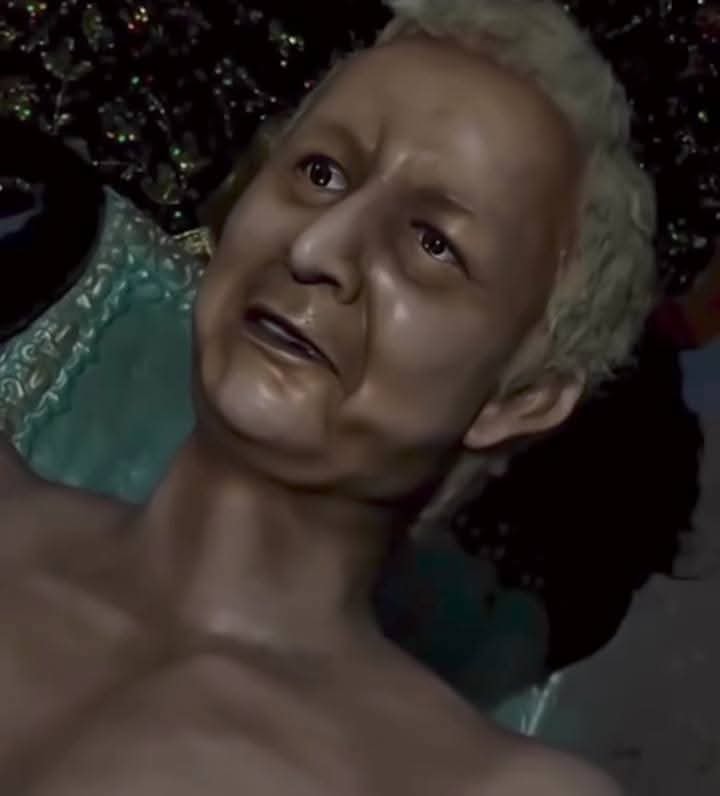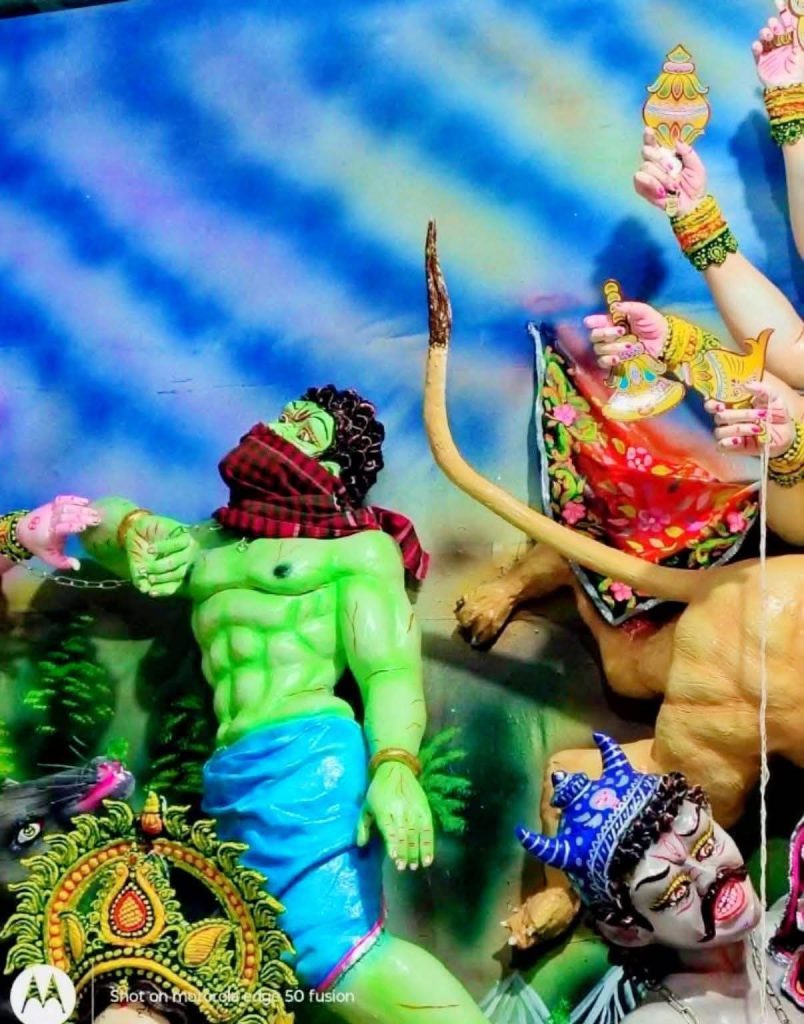Mahishasura, the demon, was a half-man, half-buffalo. He was born as a union of Rambha and Mahishi (she-buffalo). Hindus worship him during the Durga Puja as part of the rituals. The festival commemorates his defeat by Goddess Durga, symbolising the victory of good over evil and the triumph of righteousness over chaos and ignorance.
According to legend, Durga was created by the devas, the male gods of the Hindu pantheon, to slay the buffalo demon Mahishasura.
Hindus in Bangladesh, India and Nepal observe the Durga Puja by making idols of the Goddess, Lord Shiva, Mahishasura, Lord Kartik, Lord Ganeh, Goddess Saraswati and Goddess Laksmi, and worshipping them for 10 days before immersion. The main worship occurs during the last five days, with elaborate rituals, offerings, and prayers conducted in beautifully decorated pandals (temporary stages) or temples.
Every year, some artisans portray the idol of Mahishasura differently, matching the evils of contemporary society. This year, in at least one pandal of West Bengal in India, the Mahishasura idol resembles the usurper Yunus of Bangladesh, while others match Pakistan Prime Minister Shahbaz Sharif and US President Donald Trump, who have been hostile towards India for some time.

BBC Bangla ran a video story on the matter, which created a hype in Bangladesh, with Yunus himself slamming India for sheltering Sheikh Hasina since last year and the religious affairs adviser terming the portrayal extremely reprehensible and dishonourable.
Organised by the Sadhak Narendra Smriti Sangha under the theme “Dahan” (burning of evil), the idol portrayed Mahishasura with an uncanny resemblance to Yunus—complete with his signature clean-shaven face, glasses, and Nobel laureate poise.
Yunus has been condemned in India for his anti-Hindu and anti-India remarks, patronising Jamaat and jihadists to carry out mob violence, repression and corruption since capturing power last year.
In a conversation hosted by the Asia Society and Asia Society Policy Institute in New York, Yunus on Wednesday said that fake news from India further escalated tensions in Bangladesh. He said: “They even said I’m a Taliban. I don’t have a beard. I just left it at home.” Yunus maintained that the attacks on Hindu and other minorities post-August 5 were political, not communal in nature.
Sajeeb Wazed: Rise of extremism brought back dark days of minority persecution
Minority rights group laments Yunus’ denial of communal violence
On the other hand, Adviser Dr. AFM Khalid Hossain, the same day, said that there may be political differences or debates between the people of Bangladesh and India. Therefore, it is indecent and sad to present the head of government of one country as an asura or devil in another country. Those who did this did not do well. It destroys people’s sense of respect for others.
Sheikh Hasina, exiled in India, lambasted Yunus in a September 27 message: “Bangladeshis are held hostage by bigots during the festival,” alleging unchecked atrocities against Hindus.
How Mahishasur’s face hurt the feelings
In Kushtia, the authorities and Touhidi Janata—a common platform of radical Islamist mobs—forced organisers of 38 puja pavilions to remove the beard on Mahishasur’s face, or otherwise hide it with a piece of cloth.
They allege that the depiction of the idol with a beard hurt the sentiment of the Muslims, who consider idol worship as haram and creation or veneration of idols is seen as shirk.
Similar actions were taken against more pavilions in some other places in Bangladesh.
Sheikh Hasina greets Hindus on Durga Puja
Awami League condemns attacks on Durga Puja pavilions, shrines
From Sunday night, pictures of Mahishasur’s faces being covered with towels and red cloths were spread on Facebook. Comments for and against these films can be seen throughout the day on Monday.
Debesh Chandra Biswas, convener of Kushtia District Puja Celebration Front, posted some pictures from his Facebook account at night and captioned it: “Due to the beard and moustache [of Mahishasura], Kushtia district administration and police administration have covered the demon’s face with a towel in 38 temples of Kushtia district.”
However, he removed the post at night.

At around 11:30pm, Shuk Lal, the general secretary of Millline Phul Bagan Harijan Temple Committee, said that an SI of the local police outpost came to the temple at night and told him that the beard on the face of the demon must be removed at night. He was instructed by his seniors.
Idols vandalised in four districts ahead of Durga Puja festivities
Jihadists blueprint to sabotage Durga Puja in Bangladesh and India
Bangladesh’s minority rights group concerned over possible exodus to India
“Later, I asked my son to bring a towel from home and cover the demon’s face. I opened my mouth again in the morning.”
Debesh Chandra Biswas said: “Drawing a beard and moustache on the face of the Mahishasura is an art. An artisan does it from the heart. Why is there no obligation here? In Hindu scriptures, saints and sages also wore beards. Moreover, the beard on the face of the demon is nothing new. I think some group has done this to destroy harmony.”
Regarding the removal of the post from Facebook, he said: “I was forced to remove the post.”
General Secretary of the Puja Ujjapan Parishad’s Central Committee has made a statement expressing concern about the distorted representation of Mahishasura in some pavilions across the country.
“It is a history of thousands of years. Moreover, as far as I know, in the scriptures, Mahishasura did not cut his hair and beard before dying. And drawing a beard and moustache on the face of a demon is nothing new. It has been happening since time immemorial. So, I don’t understand why there is a debate about it.”
Kushtia District Police Spokesperson and Additional Superintendent of Police Faisal Mahmud said: “It was done in collaboration with the district administration. I went to various puja mandaps and advised them about the contentious issues that may arise so that there is no rift in any kind of social harmony.”
Deputy Commissioner Abu Hasnat Mohammad Arefin said that the organisers themselves settled the matter in consultation with the local public, political figures, civil society and taking everyone into confidence.